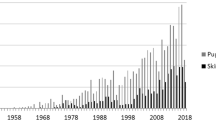Abstract
Purpose
The Freiburg Visual Acuity Test (FrACT) has been suggested as a promising test for quantifying the visual acuity (VA) of patients with very low vision, a condition often classified using the semi-quantitative clinical scale “counting fingers” (CF), “hand motion” (HM), “light perception” (LP) and “no light perception”. The present study was designed to assess FrACT performance in a sizable number of CF, HM, and LP patients in order to generate a setting for future clinical studies in the low vision range.
Methods
We examined a total of 41 patients (LP, n = 11; CF, n = 15; HM, n = 15) with various eye diseases (e.g., diabetic retinopathy, ARMD), covering the clinical VA scale from LP to CF. The FrACT optotypes were presented at a distance of 50 cm on a 17-inch LCD monitor with four random orientations. After training, two FrACT measurements (test and retest) were taken, each comprising 30 trials.
Results
FrACT measures reproducibly the VA of CF and HM patients. In CF patients, FrACT resulted in a mean logMAR = 1.98 ± 0.24 (corresponding to a decimal VA of 0.010), for HM in a mean logMAR = 2.28 ± 0.15 (corresponding to a decimal VA of 0.0052). In all LP patients the FrACT values were close to what would be obtained by random guessing. The mean test–retest 95% confidence interval was 0.21 logMAR for CF patients and 0.31 logMAR for HM respectively. Test-retest variability declined from 24 to 30 trials, showing that at least 30 trials are necessary.
Conclusion
FrACT can reproducibly quantify VA in the CF and HM range. We observed a floor effect for LP, and it was not quantifiable further. Quantitative VA measures are thus obtainable in the very low-vision range using FrACT.




Similar content being viewed by others
References
Early Treatment Diabetic Retinopathy Study Group (1991) Early Treatment Diabetic Retinopathy Study design and baseline patient characteristics. ETDRS report number 7. Ophthalmology 98:741–756
Arditi A, Cagenello R (1993) On the statistical reliability of letter-chart visual acuity measurements. Invest Ophthalmol Vis Sci 34:120–129
Bach M (1996) The Freiburg Visual Acuity Test – Automatic measurement of visual acuity. Optom Vis Sci 73:49–53, doi:10.1097/00006324-199601000-00008
Bach M (1997) Anti-aliasing and dithering in the Freiburg Visual Acuity Test. Spat Vis 11:85–89, doi:10.1163/156856897X00087
Bach M (2006) Homepage of the Freiburg Visual Acuity and Contrast Test (‘FrACT’). Retrieved 2007-04-17, from <http://www.michaelbach.de/fract.html>;
Bach M (2007) The Freiburg Visual Acuity Test-Variability unchanged by post-hoc re-analysis. Graefes Arch Clin Exp Ophthalmol 245:965–971, doi:10.1007/s00417-006-0474-4
Beck RW, Moke PS, Turpin AH, Ferris FL 3rd, SanGiovanni JP, Johnson CA et al (2003) A computerized method of visual acuity testing: adaptation of the early treatment of diabetic retinopathy study testing protocol. Am J Ophthalmol 135:194–205, doi:10.1016/S0002-9394(02)01825-1
Colenbrander A (2002) Visual standards aspects and ranges of vision loss with emphasis on Population Surveys. Report prepared for the International Council of Ophthalmology at the 29th International Congress of Ophthalmology Sydney, Australia, April 2002
Colenbrander A, Fletcher DC (1990) Visual acuity measurements in low vision patients. J Vis Rehab 4:1–9
Dennis RJ, Beer JM, Baldwin JB, Ivan DJ, Lorusso FJ, Thompson WT (2004) Using the Freiburg Acuity and Contrast Test to measure visual performance in USAF personnel after PRK. Optom Vis Sci 81:516–524, doi:10.1097/00006324-200407000-00013
Ferris FL 3rd, Kassoff A, Bresnick GH, Bailey I (1982) New visual acuity charts for clinical research. Am J Ophthalmol 94:91–96
Grover S, Fishman GA, Anderson RJ, Tozatti MS, Heckenlively JR, Weleber RG et al (1999) Visual acuity impairment in patients with retinitis pigmentosa at age 45 years or older. Ophthalmology 106:1780–1785, doi:10.1016/S0161-6420(99)90342-1
Holladay JT (1997) Proper method for calculating average visual acuity. J Refract Surg 13:388–391
Kiser AK, Mladenovich D, Eshraghi F, Bourdeau D, Dagnelie G (2005) Reliability and consistency of visual acuity and contrast sensitivity measures in advanced eye disease. Optom Vis Sci 82:946–954, doi:10.1097/01.opx.0000187863.12609.7b
Lieberman HR, Pentland AP (1982) Microcomputer-based estimation of psychophysical thresholds: The best PEST. Behav Res Meth Instrum 14:21–25
Loumann Knudsen L (2003) Visual acuity testing in diabetic subjects: the decimal progression chart versus the Freiburg visual acuity test. Graefes Arch Clin Exp Ophthalmol 241:615–618, doi:10.1007/s00417-003-0707-8
Schulze-Bonsel K, Feltgen N, Burau H, Hansen LL, Bach M (2006) Visual acuities “Hand Motion” and “Counting Fingers” can be quantified using the Freiburg Visual Acuity Test. Invest Ophthalmol Vis Sci 47:1236–1240, doi:10.1167/iovs.05-0981
Treutwein B (1995) Adaptive psychophysical procedures. Vision Res 35:2503–2522
Wesemann W (2002) Visual acuity measured via the Freiburg visual acuity test (FVT), Bailey Lovie chart and Landolt Ring chart. Klin Monatsbl Augenheilkd 219:660–667, doi:10.1055/s-2002-35168
World Medical Association (2000) Declaration of Helsinki: ethical principles for medical research involving human subjects. JAMA 284:3043–3045, doi:10.1001/jama.284.23.3043
Author information
Authors and Affiliations
Corresponding author
Rights and permissions
About this article
Cite this article
Lange, C., Feltgen, N., Junker, B. et al. Resolving the clinical acuity categories “hand motion” and “counting fingers” using the Freiburg Visual Acuity Test (FrACT). Graefes Arch Clin Exp Ophthalmol 247, 137–142 (2009). https://doi.org/10.1007/s00417-008-0926-0
Received:
Revised:
Accepted:
Published:
Issue Date:
DOI: https://doi.org/10.1007/s00417-008-0926-0




